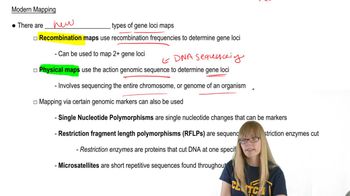Table of contents
- 1. Introduction to Genetics51m
- 2. Mendel's Laws of Inheritance3h 37m
- 3. Extensions to Mendelian Inheritance2h 41m
- 4. Genetic Mapping and Linkage2h 28m
- 5. Genetics of Bacteria and Viruses1h 21m
- 6. Chromosomal Variation1h 48m
- 7. DNA and Chromosome Structure56m
- 8. DNA Replication1h 10m
- 9. Mitosis and Meiosis1h 34m
- 10. Transcription1h 0m
- 11. Translation58m
- 12. Gene Regulation in Prokaryotes1h 19m
- 13. Gene Regulation in Eukaryotes44m
- 14. Genetic Control of Development44m
- 15. Genomes and Genomics1h 50m
- 16. Transposable Elements47m
- 17. Mutation, Repair, and Recombination1h 6m
- 18. Molecular Genetic Tools19m
- 19. Cancer Genetics29m
- 20. Quantitative Genetics1h 26m
- 21. Population Genetics50m
- 22. Evolutionary Genetics29m
4. Genetic Mapping and Linkage
Mapping Genes
Problem 35a
Textbook Question
Based on previous family studies, an autosomal recessive disease with alleles A and a is suspected to be linked to an RFLP marker. The RFLP marker has four alleles, R₁, R₂, R₃, and R₄. The accompanying pedigree shows a three-generation family in which the disease is present. The gel shows the RFLP alleles for each family member directly below the pedigree symbol for that person. After determining the genotypes for the RFLP and disease gene for each family member, answer the following questions. Based on your analysis, what is the recombination frequency in this family? Explain how you obtained your answer.
 Verified step by step guidance
Verified step by step guidance1
Identify the genotypes of each family member for both the disease gene (A, a) and the RFLP marker alleles (R₁, R₂, R₃, R₄) using the pedigree and gel electrophoresis results.
Determine which family members are affected by the autosomal recessive disease, indicating they must have the genotype 'aa'.
Analyze the inheritance pattern of the RFLP marker alleles in relation to the disease alleles to identify any recombination events. A recombination event occurs when the combination of alleles in the offspring differs from that of the parents.
Count the number of recombination events observed in the family. This involves identifying offspring whose combination of disease and RFLP alleles does not match the expected parental combination.
Calculate the recombination frequency by dividing the number of recombination events by the total number of offspring, then multiply by 100 to express it as a percentage.
Recommended similar problem, with video answer:
 Verified Solution
Verified SolutionThis video solution was recommended by our tutors as helpful for the problem above
Video duration:
3mPlay a video:
Was this helpful?
Key Concepts
Here are the essential concepts you must grasp in order to answer the question correctly.
Autosomal Recessive Inheritance
Autosomal recessive inheritance refers to a pattern where two copies of a mutated gene (one from each parent) are necessary for an individual to express a trait or disease. In this case, alleles A (normal) and a (mutated) determine the presence of the disease. Individuals with the genotype aa will exhibit the disease, while those with AA or Aa will not. Understanding this inheritance pattern is crucial for analyzing the pedigree and determining affected individuals.
Recommended video:
Guided course

Autosomal Pedigrees
Restriction Fragment Length Polymorphism (RFLP)
RFLP is a molecular technique used to analyze the length of DNA fragments produced by restriction enzyme digestion. Variations in DNA sequences can lead to different fragment lengths, which can be visualized on a gel. In this scenario, the RFLP marker with alleles R₁, R₂, R₃, and R₄ helps identify genetic linkage to the disease gene. Analyzing these fragments allows researchers to infer genotypes and potential inheritance patterns.
Recommended video:
Guided course

Mapping with Markers
Recombination Frequency
Recombination frequency is a measure of the likelihood that two genes will be separated during meiosis due to crossing over. It is calculated by dividing the number of recombinant offspring by the total number of offspring. In this context, determining the recombination frequency between the disease gene and the RFLP marker helps assess their genetic linkage, which is essential for understanding inheritance patterns in the family pedigree.
Recommended video:
Guided course

Recombination after Single Strand Breaks
Related Videos
Related Practice





